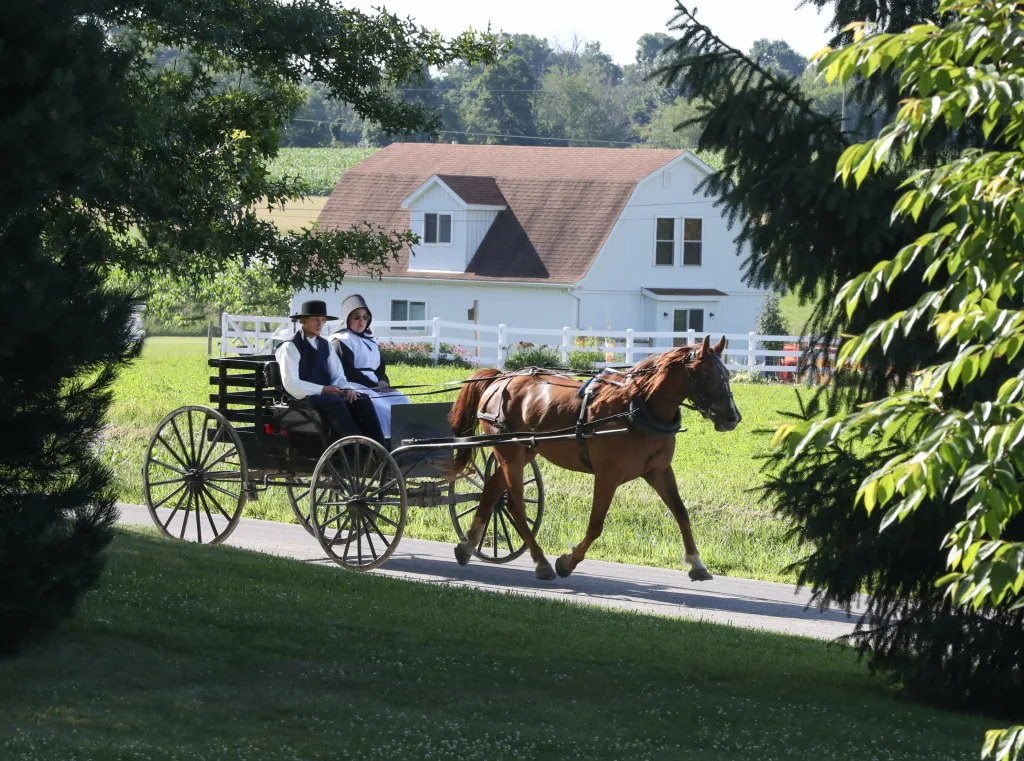The topic of the Amish and their use of electricity is a fascinating one. Many people wonder why the Amish choose not to utilize the conveniences of modern technology, particularly electricity. While it may seem like a simple rejection of progress, the reality is far more complex.
Firstly, it is important to note that the Amish do not completely shun electricity. They do have electricity in their homes, but they do not rely on the public power grid. This is a deliberate choice, rooted in their desire to maintain their distinct way of life and avoid excessive dependence on the outside world.
The Amish believe that too much reliance on electricity and access to public power grids can erode their closely-knit community and compromise their traditional values. They fear that an overreliance on technology will lead to a loss of self-sufficiency and a weakening of their cultural identity.
Instead of connecting to the public electric grid, Amish families and businesses often turn to alternative energy sources such as generators. These generators are used to power their appliances and machines, allowing them to maintain a level of comfort and convenience while still adhering to their beliefs.
Lighting is another aspect where the Amish have found alternative solutions. Natural and propane gas lamps are commonly used in Amish households as a lighting source. These lamps provide a warm and soothing glow, creating a cozy atmosphere in their homes. Additionally, traditional oil lamps, with their teardrop glass wicks, are still prevalent in more traditional Amish households, adding a touch of nostalgia to their way of life.
It’s important to understand that the Amish’s decision to limit their use of electricity is not a rejection of progress or a condemnation of technology itself. Rather, it is a conscious choice to preserve their unique culture and maintain a simpler, more self-sufficient lifestyle.
By relying on alternative energy sources and traditional lighting methods, the Amish are able to strike a balance between embracing limited modern conveniences and honoring their commitment to living a traditional and meaningful life.
The Amish do have electricity in their homes, but they choose not to connect to the public power grid in order to preserve their cultural identity and way of life. They rely on generators and alternative energy sources for their power needs, while using natural gas, propane lamps, and traditional oil lamps for lighting. Their decision to limit their use of electricity is a deliberate choice to maintain a simpler and more self-sufficient lifestyle.
Why Do Amish Not Allow Electricity?
The Amish do not completely prohibit the use of electricity, but they do limit its usage. The rationale behind this limitation stems from their desire to maintain a simple and self-sufficient way of life, which is central to their cultural and religious beliefs. Here are some key reasons why the Amish choose to restrict their reliance on electricity:
1. Cultural Preservation: The Amish prioritize the preservation of their distinct culture, which emphasizes separation from the modern world. By limiting the use of electricity, they believe they can avoid becoming too dependent on outside influences, ensuring the preservation of their unique traditions, values, and way of life.
2. Minimalism and Simplicity: The Amish value a simple and humble existence, focusing on essential needs rather than materialistic desires. By avoiding excessive use of electricity, they can prevent the temptations and distractions that modern technology often brings, allowing them to lead a more spiritually fulfilling life.
3. Community Cohesion: The Amish community places a strong emphasis on close-knit relationships and mutual support. They believe that excessive use of electricity would lead to individualism and weaken the bonds within the community. By limiting access to electricity, they encourage face-to-face interactions and foster a sense of communal interdependence.
4. Environmental Stewardship: The Amish have a deep respect for nature and strive to live in harmony with it. By minimizing their use of electricity, they can reduce their ecological footprint and minimize the negative impact on the environment. This aligns with their commitment to sustainable living and responsible stewardship of the Earth.
5. Work Ethic and Self-Sufficiency: The Amish place great importance on hard work, self-reliance, and the development of practical skills. By abstaining from relying heavily on electricity, they maintain a hands-on approach to daily tasks, such as farming, woodworking, and other traditional crafts. This way, they can pass down these skills from generation to generation, ensuring their self-sufficiency and resilience.
It is important to note that the level of acceptance and usage of electricity may vary among different Amish communities, with some being more lenient than others. However, the underlying principles of cultural preservation, simplicity, community, environmental stewardship, and self-sufficiency remain core reasons for the Amish’s limited reliance on electricity.

What Do The Amish Believe About Electricity?
The Amish hold varying beliefs about electricity, and it is important to note that their stance is not solely based on a rejection of electricity itself. The use of electricity in Amish communities is influenced by their commitment to a simple and traditional way of life, and their desire to maintain separation from the modern world.
1. Limited use: Generally, the Amish do not completely reject electricity. They do, however, restrict its use in their daily lives. This limitation is primarily aimed at avoiding the potential negative effects of modern technology and preserving their distinct lifestyle.
2. Household items: In most Amish households, electricity is not used for general purposes such as powering appliances and electronic devices. However, they are allowed to use electricity for specific purposes, such as running household items like lamps, sewing machines, or kitchen appliances. These items are typically operated using alternative power sources like batteries, compressed air, or hydraulic power, which align with their commitment to simplicity.
3. Farming and business: In agricultural settings, Amish communities may utilize electricity for certain farming operations. For instance, they may use electric engines to power machinery such as milking machines or refrigeration units. Some Amish businesses, like woodworking shops, may also employ electricity for powering tools and equipment necessary for their trade.
4. Community considerations: The Amish approach to electricity is not solely based on individual beliefs but is also shaped by community consensus. Decisions regarding the use of electricity are often made collectively, with community leaders and church authorities providing guidance. This ensures consistency and preserves the communal nature of decision-making within the Amish society.
5. Safety concerns: Another factor that influences the Amish stance on electricity is safety. They believe that the use of electricity can introduce potential dangers and distractions that may disrupt their close-knit community and traditional way of life. By limiting their exposure to modern technology, they aim to reduce the potential risks associated with it.
It is important to understand that Amish beliefs and practices can vary among different communities and even among individual households. While the general principles regarding electricity usage remain consistent, specific guidelines and practices may differ based on local traditions, cultural norms, and interpretations of Amish teachings.
Are The Amish Allowed To Use Electricity?
The Amish are allowed to use electricity. While they adhere to a traditional lifestyle and reject many modern technologies, they do make use of electricity in their homes and businesses. However, it’s important to note that the way they access and utilize electricity differs from the mainstream practice.
Instead of being connected to the public electric grid, the Amish generate their own electricity through alternative means. These include the use of generators, solar panels, wind turbines, and even hydraulic systems. This self-sufficiency allows them to maintain their separation from the outside world while still meeting their basic electricity needs.
It’s worth mentioning that the Amish have certain restrictions on the use of electricity. They typically avoid using appliances that they consider too modern or that may disrupt their simple way of life. This means that while they may have basic electrical appliances such as refrigerators, stoves, and washing machines, they often opt for simpler, non-electric versions or ones that are adapted to work with their alternative power sources.
The Amish are permitted to use electricity, but they rely on alternative energy sources and have limitations on the types of appliances they use to preserve their traditional lifestyle.
How Do The Amish Live Without Electricity?
The Amish community has chosen to live without electricity as a means of preserving their traditional way of life and maintaining a strong sense of community. While they do not use electricity for everyday tasks, such as lighting their homes or powering appliances, they have found alternative methods to meet their needs. Here are some ways in which the Amish live without electricity:
1. Gas lamps: Natural and propane gas lamps are commonly used in Amish households as a source of lighting. These lamps provide a bright and steady light, making them suitable for various activities at home.
2. Oil lamps: Many traditional Amish households still rely on oil lamps for lighting. These lamps, often made of glass with a teardrop shape, use wicks and kerosene oil to create a warm and soothing glow. Oil lamps are particularly popular in the more old-fashioned Amish homes.
3. Natural light: The Amish make the most of natural light during the day. They design their homes to maximize sunlight, with large windows and open spaces that allow plenty of light to enter. This not only helps with illumination but also creates a sense of connection to the outdoors.
4. Reflective surfaces: To further enhance the use of natural light, the Amish often incorporate reflective surfaces into their homes. Mirrors, polished metal, and light-colored walls or ceilings help to bounce and spread the available light, making the spaces brighter and more inviting.
5. Hand-powered tools: Instead of relying on electric appliances, the Amish use a variety of hand-powered tools and equipment. This includes manual kitchen appliances like butter churns, hand-powered sewing machines, and hand-cranked generators for limited electricity needs, such as charging batteries or operating small devices.
6. Wood-burning stoves: For cooking and heating, the Amish commonly use wood-burning stoves. These stoves provide warmth and can be used for cooking meals, baking, and even heating water.
7. Natural cooling methods: Without the use of electric fans or air conditioning, the Amish rely on natural cooling methods. This can include strategic home design that promotes airflow, using shade trees, and utilizing screened-in porches or outdoor spaces to catch breezes.
8. Simple living: the Amish lifestyle focuses on simplicity and self-sufficiency. By living without electricity, they prioritize a slower pace of life, more meaningful interactions, and a stronger connection to nature and their community.
It’s important to note that while the Amish choose to live without electricity, some communities may have limited access to certain modern conveniences for specific purposes, such as using shared electricity in community buildings or utilizing battery-powered devices when necessary. However, these exceptions are generally kept to a minimum to maintain their desired way of life.

Conclusion
The Amish approach to electricity is rooted in their desire to preserve their unique culture and way of life. While they do not reject electricity altogether, they limit their reliance on it to avoid becoming too connected to the outside world. Instead of being connected to public power grids, Amish households and businesses use alternative energy sources such as generators. They also utilize natural and propane gas lamps as well as oil lamps for lighting. This careful balance of incorporating electricity for practical purposes while maintaining their traditional practices showcases the Amish commitment to living a simpler, self-sufficient lifestyle. By understanding and respecting these beliefs, we can gain a greater appreciation for the Amish community and their commitment to preserving their rich cultural heritage.
